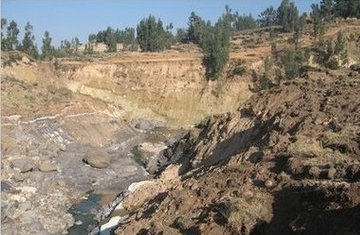
Above: A view of Mush River near Addis Ababa, with its dark
fossil-bearing shales. Photograph by Bonnie F Jacobs via NYT.
The New York Times
By BONNIE F. JACOBS

Posted: December 29, 2010, 4:55 pm
Bonnie F. Jacobs, a paleobotanist at Southern Methodist University, writes from Ethiopia, where she is studying fossils of ancient plant and animal life. The current field season in the Mush Valley of Ethiopia is financed by a grant to Ellen Currano of Miami University, Ohio, from the National Geographic Society Committee on Research and Exploration.
Monday, Dec. 27
This winter’s field season in Ethiopia is my tenth since I began working there, and despite my experience I am filled with anticipation. Our project is a relatively new one — studying rocks and fossils from an important period of history, 22 million years ago — and the location, Mush Valley, is also somewhat new to our team (last year was our first collecting trip here).
Mush Valley is only about 160 kilometers northeast of the modern capital city, Addis Ababa, but it feels as though it could be a thousand miles away. Very little of city life intrudes into the villages of Upper and Lower Mush.
What really takes me away from it all are the rocks and fossils exposed by and alongside the Mush River. They provide us an exciting opportunity to document life, climate, landscape and atmosphere 22 million years ago. As we excavate blocks of fine-grained sediment — primarily shale — looking for clues to the past, the pivotal role played by that ancient time period is always on our mind.
Why is it important to know about the Ethiopian Plateau 22 million years ago? The Mush Valley preserves plants and animals from a time soon after a land connection was established between Afro-Arabia and Eurasia — a land connection that marked the end of Africa’s island status and that was used by animals to migrate between the two previously separated land masses. By looking at the fossil record from that period of time — before the Red Sea was formed — we can gain a clearer view of which species survived this great migration and which did not.
Latest related post from NYT:
January 4, 2011: Evidence of Mammals and Legumes, 22 Million Years Old

























